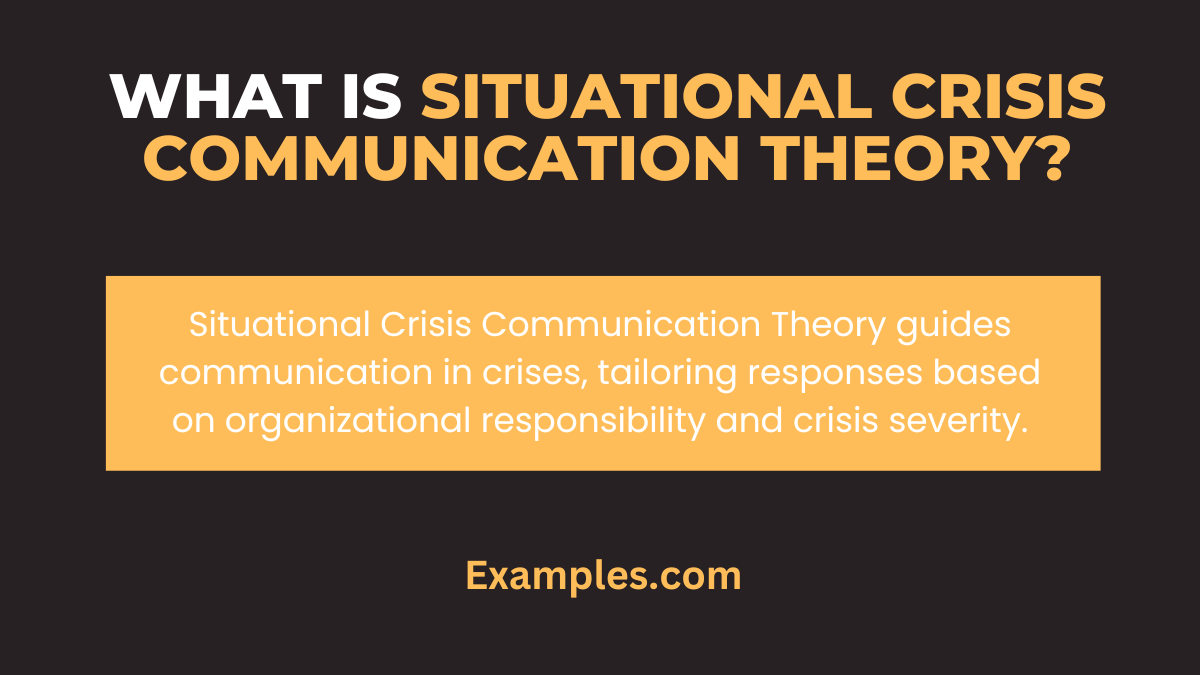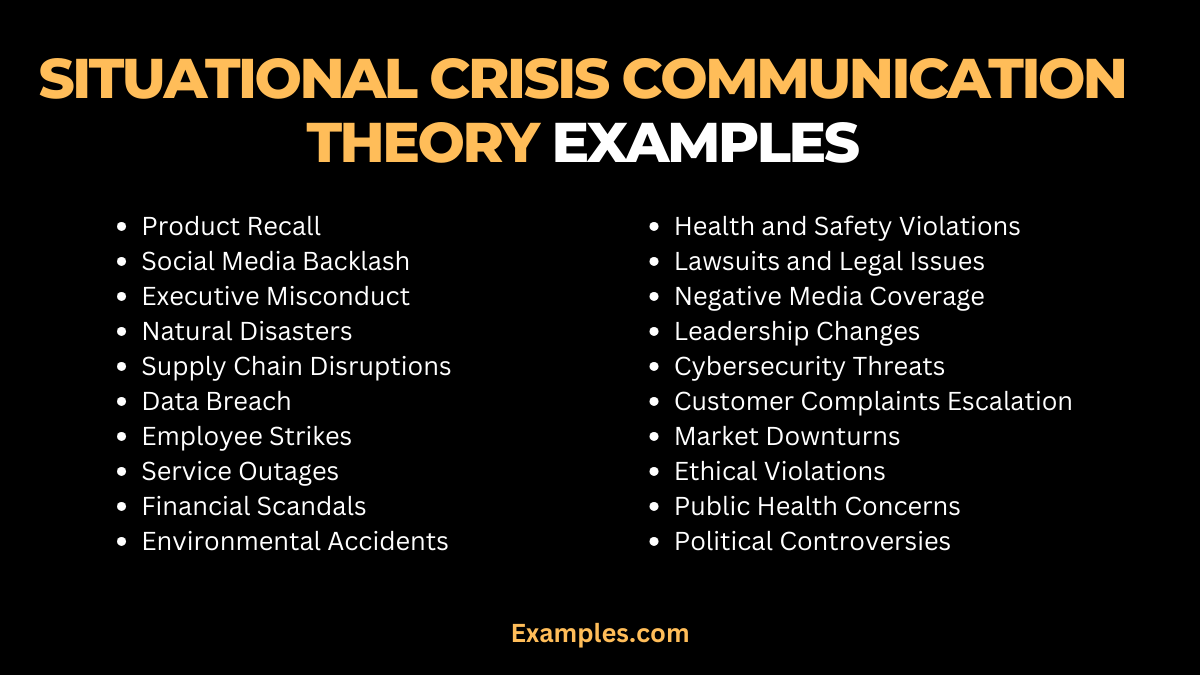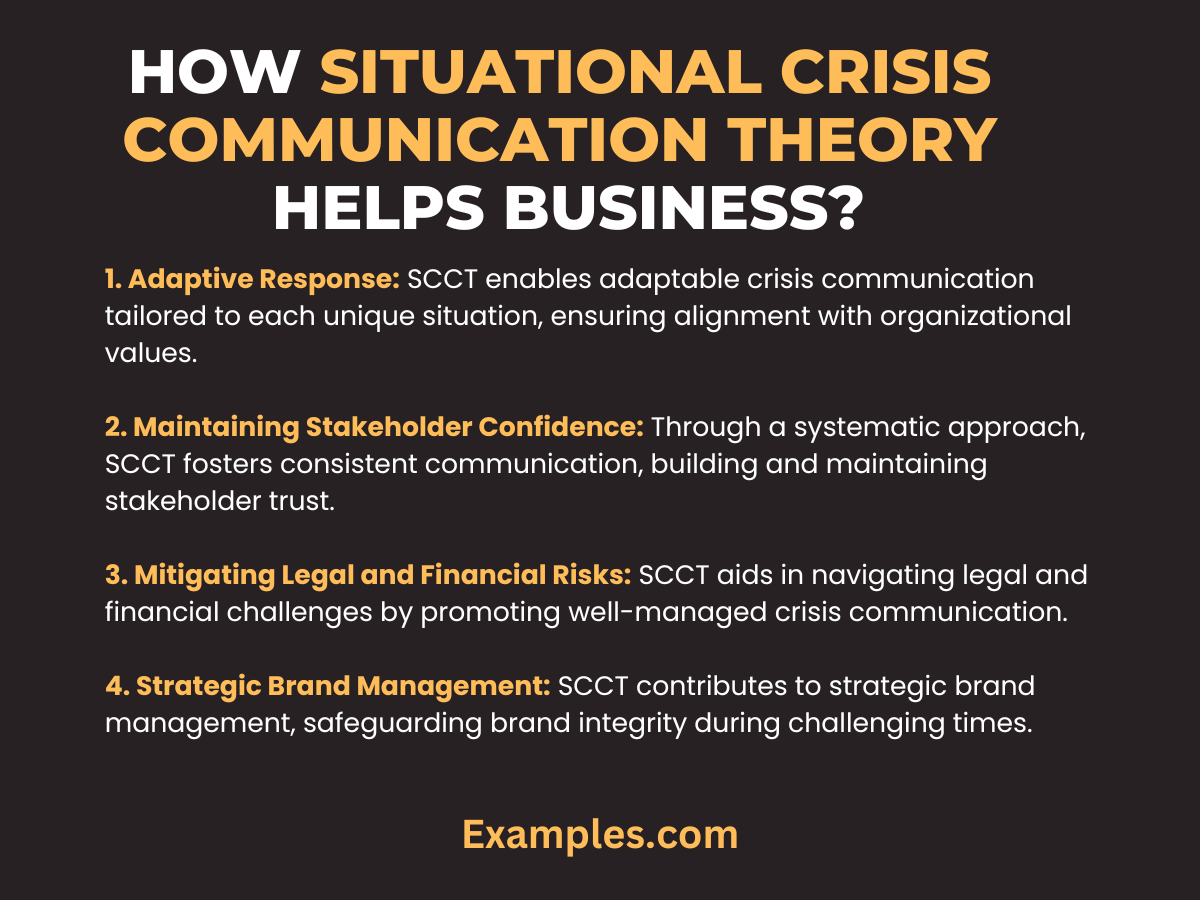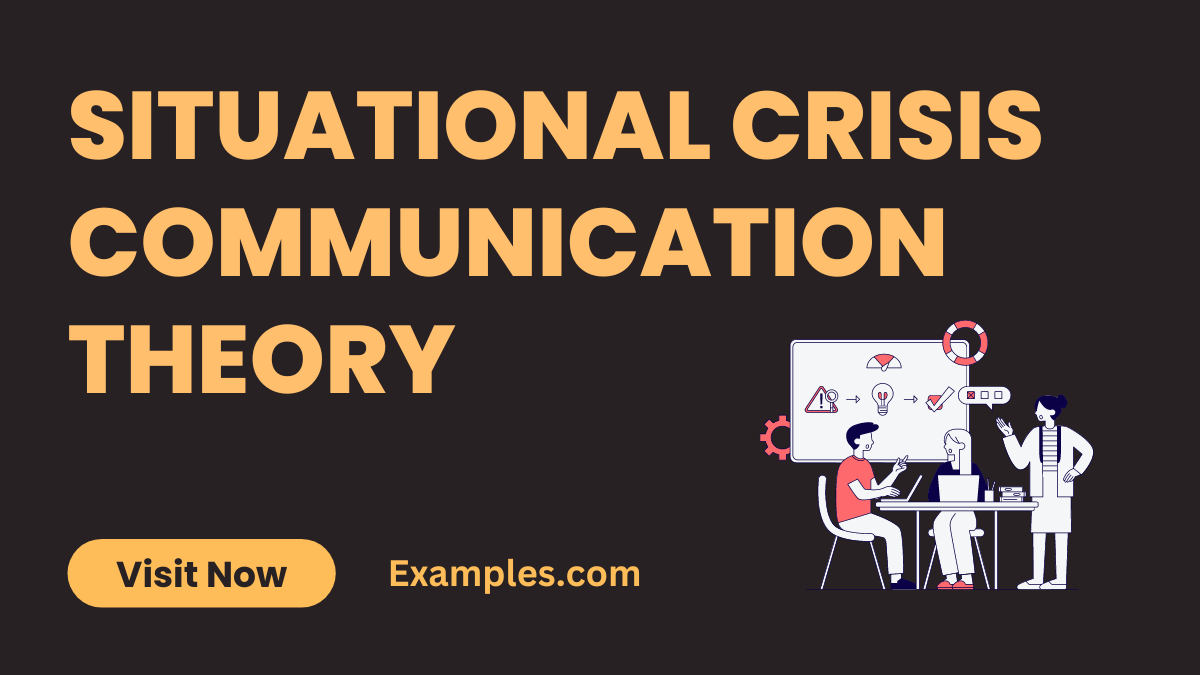19+ Situational Crisis Communication Theory (SCCT) Examples
Embark on a comprehensive journey through the Situational Crisis Communication Theory (SCCT) in this definitive guide enriched with practical examples. Unveil the nuances of effective crisis communication and discover how SCCT transforms challenging scenarios. From communication examples to actionable insights, this guide equips you to navigate crises with confidence, making it an invaluable resource for honing your communication skills in the face of adversity. Explore the dynamic interplay of theory and real-world application for mastery in crisis communication.
What is Situational Crisis Communication Theory?

Situational Crisis Communication Theory (SCCT) is a strategic framework designed to guide effective communication during times of crisis. In simple terms, SCCT helps organizations tailor their messages based on the nature and severity of a crisis. It emphasizes the importance of considering public perceptions and adjusting communication strategies accordingly. By understanding SCCT, one gains insights into crafting messages that not only address the crisis at hand but also maintain and restore trust in the eyes of the audience.
20 Situational Crisis Communication Theory Examples

Explore 20 real-world Situational Crisis Communication Theory examples, dissected for strategic insights. From managing product recalls to navigating public scandals, each example offers a lesson in effective crisis communication. Gain a deeper understanding of SCCT principles and fortify your communication arsenal.
- Product Recall: Swiftly address concerns, ensuring transparency and outlining safety measures.
- Social Media Backlash: Respond promptly, acknowledging concerns and providing reassurance.
- Executive Misconduct: Convey accountability, detailing corrective actions taken to rebuild trust.
- Natural Disasters: Offer immediate aid information, showcasing a proactive and caring stance.
- Supply Chain Disruptions: Communicate alternative solutions, minimizing customer inconvenience.
- Data Breach: Apologize, assure data security improvements, and outline compensation measures.
- Employee Strikes: Engage in open dialogue, addressing concerns and demonstrating commitment.
- Service Outages: Keep customers informed, offering realistic resolution timelines.
- Financial Scandals: Publicly admit faults, outline corrective measures, and commit to transparency.
- Environmental Accidents: Assume responsibility, provide cleanup details, and promise preventive measures.
- Health and Safety Violations: Communicate immediate corrective actions and prevention strategies.
- Lawsuits and Legal Issues: Offer transparent statements, highlighting compliance with legal processes.
- Negative Media Coverage: Address inaccuracies, clarify facts, and present the organization’s perspective.
- Leadership Changes: Articulate the vision for the future, ensuring a smooth transition.
- Cybersecurity Threats: Assure data protection measures, detailing cybersecurity enhancements.
- Customer Complaints Escalation: Respond empathetically, offering personalized resolutions.
- Market Downturns: Communicate adaptive strategies, assuring stakeholders of recovery plans.
- Ethical Violations: Express remorse, share corrective actions, and recommit to ethical practices.
- Public Health Concerns: Disseminate accurate information promptly, showcasing preventive measures.
- Political Controversies: Remain neutral, focus on the organizational mission, and avoid taking sides.
Situational Crisis Communication Theory Examples for Student Organizations
Discover how Situational Crisis Communication Theory applies to student organizations, ensuring effective crisis management and preserving organizational reputation. Explore unique examples tailored to the challenges faced by student-led groups, providing valuable insights into crisis communication strategies in educational settings.
- Fund Mismanagement: Transparently address financial discrepancies, communicate corrective actions, and involve the student body in improved financial oversight.
- Leadership Controversy: Engage in open forums, address concerns, and ensure transparent communication to rebuild trust in the leadership.
- Event Cancellations: Apologize for any inconvenience, communicate alternative plans or compensations, and involve students in future decision-making.
- Social Media Backlash: Respond promptly to negative comments, acknowledge concerns, and showcase proactive measures to address any issues raised.
- Academic Integrity Violation: Clearly communicate actions taken to address the violation, emphasize organizational commitment to academic integrity, and implement preventive measures.
Situational Crisis Communication Theory Examples in Case Study
Description: Delve into real-life case studies demonstrating the application of Situational Crisis Communication Theory. Explore how organizations navigate diverse crises, applying SCCT principles for effective communication and reputation management. Gain actionable insights from these dynamic examples to enhance your crisis communication skills.
- Product Recall Case: Swiftly communicate the recall, provide detailed information on replacement or compensation, and assure consumers of enhanced quality control measures.
- Environmental Disaster Case: Assume responsibility, communicate immediate response actions, and outline long-term sustainability initiatives to rebuild public trust.
- Employee Misconduct Case: Publicly acknowledge the misconduct, detail corrective actions taken, and emphasize organizational values to restore faith in the company.
- Market Competition Challenge: Communicate adaptive strategies, reassure stakeholders of competitive strengths, and outline plans for market resurgence.
- Public Relations Crisis Case: Address media inaccuracies, clarify facts through a press conference, and consistently maintain open communication to shape the narrative positively.
What are Situational Crisis Communication Theory Strategies?
Situational Crisis Communication Theory (SCCT) provides strategic approaches for effective crisis communication. Key strategies include:
- Pre-Crisis Planning:
- Develop proactive communication plans.
- Identify potential crises and formulate tailored responses.
- Response Strategies:
- Adopt crisis response strategies based on the severity of the situation.
- Determine whether to deny, diminish, rebuild, bolster, or bolster with differentiation.
- Coordination with Stakeholders:
- Establish clear communication channels with internal and external stakeholders.
- Collaborate with key entities for a unified crisis response.
- Transparency and Openness:
- Prioritize transparency in communication.
- Share information openly to maintain credibility.
- Adaptive Messaging:
- Tailor messages to the specific crisis and audience.
- Adjust communication style based on the evolving situation.
- Media Relations:
- Engage with media effectively.
- Provide accurate information promptly to shape public perception.
- Learning and Improvement:
- Conduct post-crisis evaluations.
- Learn from experiences to enhance future crisis communication strategies.
What is the Importance of Situational Crisis Communication Theory?
Understanding the significance of SCCT is crucial for effective crisis management:
- Preserving Reputation:
- SCCT helps organizations maintain a positive image during crises.
- Preserving reputation is vital for long-term success.
- Tailored Communication:
- SCCT enables customized messaging based on crisis severity.
- Tailored communication resonates better with stakeholders.
- Building Trust:
- Transparent communication fosters trust.
- Trust is pivotal for stakeholder loyalty and support.
- Reducing Negative Impact:
- SCCT minimizes the negative impact of crises.
- Swift and well-crafted communication can mitigate fallout.
- Strategic Decision-Making:
- SCCT guides strategic decision-making during crises.
- It provides a framework for choosing appropriate communication responses.
How Situational Crisis Communication Theory Helps Business?

- Adaptive Response: SCCT enables adaptable crisis communication tailored to each unique situation, ensuring alignment with organizational values.
- Maintaining Stakeholder Confidence: Through a systematic approach, SCCT fosters consistent communication, building and maintaining stakeholder trust.
- Mitigating Legal and Financial Risks: SCCT aids in navigating legal and financial challenges by promoting well-managed crisis communication.
- Strategic Brand Management: SCCT contributes to strategic brand management, safeguarding brand integrity during challenging times.
- Long-Term Resilience: Incorporating SCCT principles enhances long-term resilience, preparing businesses to navigate and overcome crises effectively.
In conclusion, navigating crises demands strategic communication, and Situational Crisis Communication Theory (SCCT) offers a vital framework. This complete guide has unraveled SCCT, providing insights into its strategies and showcasing real-world examples. Armed with this knowledge, communicators can adeptly steer through challenging situations, ensuring effective responses and safeguarding organizational reputation. Mastering SCCT is not just a choice; it’s a necessity for resilient and successful crisis communication.



